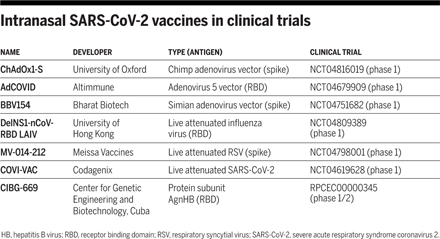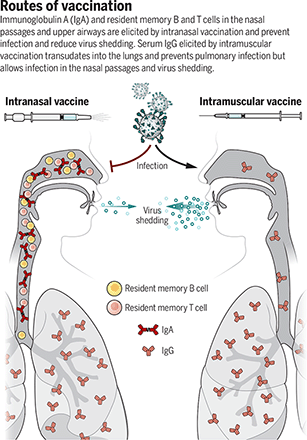The highly contagious severe acute respiratory syndrome coronavirus 2 (SARS-CoV-2) infects the respiratory tract and is transmitted, in part, by respiratory droplets and aerosols. Consequently, unvaccinated people are encouraged to wear masks in public, self-quarantine if symptomatic, and practice social distancing. Despite these precautions, millions are dying. As the pandemic takes its toll, vaccines are once again headline news, notably for the speed of their development and the success of messenger RNA (mRNA) vaccines. Given the respiratory tropism of the virus, however, it seems surprising that only seven of the nearly 100 SARS-CoV-2 vaccines currently in clinical trials are delivered intranasally. Advantages of intranasal vaccines include needle-free administration, delivery of antigen to the site of infection, and the elicitation of mucosal immunity in the respiratory tract.
The idea that intranasal vaccination preferentially protects the respiratory tract is not new: Development of the US Food and Drug Administration (FDA)–approved live attenuated influenza vaccine (LAIV) began in the 1960s. Immunologists have long known that nasal infection or vaccination elicits an immunoglobulin A (IgA) response in both serum and respiratory fluids, whereas intramuscular vaccines primarily elicit serum IgG. IgA is particularly important in the upper airways and nasal passages, where it is actively transported across the epithelium and released into the airway lumen as a dimer bound to secretory component, a stabilizing configuration that allows it to more effectively neutralize viruses like SARS-CoV-2 (1). By contrast, IgG enters and protects the lower lung through passive transudation across the thin alveolar epithelium (2). IgG is also found in the upper respiratory tract and nasal passages, perhaps carried from the lower lung by the mucociliary escalator. However, protection of the nasal passages by IgG is only achieved at high serum concentrations (2). Consequently, intramuscular vaccines that elicit high titers of serum IgG can reduce viral titers in the lungs and nasal passages.
CD8+ T cells are another important component of antiviral immunity and directly kill virus-infected cells, thereby reducing viral replication and accelerating viral clearance and recovery. Some activated CD8+ T cells develop into memory cells, which by themselves do not prevent infection, but are poised for rapid reactivation and effector function. Notably, B and T cells primed by mucosal vaccination or infection express receptors that promote homing to mucosal sites as long-lived antibody-secreting cells or as tissue-resident memory cells. Resident memory B and T cells in the lung and nasal passages act as nonredundant, first responders to challenge infection and are essential for rapid virus clearance (3, 4). The placement of tissue-resident memory cells in the respiratory tract requires that they encounter antigen in the respiratory tract (3, 5), meaning that vaccines designed to recruit resident memory cells to the respiratory tract should be administered intranasally.
Compared to intramuscular vaccines, intranasal vaccines provide two additional layers of protection: Vaccine-elicited IgA and resident memory B and T cells in the respiratory mucosa provide an effective barrier to infection at those sites; and, even if infection does occur, perhaps by a viral variant, cross-reactive, resident memory B and T cells, which encounter antigen earlier and respond more quickly than systemic memory cells, impede viral replication and reduce viral shedding and transmission (see the figure).
Of the seven SARS-CoV-2 vaccines being tested for intranasal delivery, six are live-attenuated viruses or virus-vectored vaccines and one is a protein subunit vaccine (see the table). Attenuated viruses and viral vectors that encode vaccine antigens are particularly useful for intranasal immunization because the infection process effectively breaches the epithelium and is intrinsically immunogenic. Because vaccine antigens are expressed by infected cells, antigen presentation occurs via the class I pathway and efficiently triggers CD8+ T cell responses—an advantage over protein subunit vaccines that poorly engage CD8+ T cells.
Preclinical studies of adenovirus-vectored vaccines expressing the SARS-CoV-2 spike host receptor protein or its receptor binding domain (RBD) demonstrate that intranasal delivery triggers long-lasting, virus-neutralizing serum IgG responses as well as antigen-specific IgA and CD8+ T cells in the respiratory tract (6–8). Moreover, both intranasal and intramuscular vaccination with adenovirus-vectored vaccines protect against pneumonia and weight loss after a challenge infection. However, animals vaccinated intramuscularly still shed virus from the nasal passages, whereas animals vaccinated intranasally have reduced viral replication and shedding in both the lungs and the nasal passages (8).
Adenoviruses are natural human pathogens, and many adults have been exposed to one or more strains, meaning that they may have antivector antibodies that impair vaccine efficacy (negative interference). However, Ad5-vectored intranasal influenza vaccine (NasoVAX), administered at high doses, works similarly in Ad5 seropositive and seronegative individuals (9), perhaps because the inoculating volume dilutes local antibody concentrations. Nevertheless, in an attempt to avoid any potential negative interference, some developers are using rare strains of human adenoviruses or chimp adenoviruses, to which most humans have not been exposed.
The influenza-vectored SARS-CoV-2 vaccine being developed by the University of Hong Kong may face related hurdles. The deletion of the influenza virus gene encoding nonstructural protein 1 (NS1) strongly attenuates the vector and allows developers to replace NS1 with the SARS-CoV-2 spike-RBD. Like adenovirus-vectored vaccines, this one should also elicit mucosal IgA against RBD and place resident memory cells in the respiratory tract. However, negative interference from preexisting antibodies against the influenza vector may impair its effectiveness. Similarly, Meissa Vaccines developed a live attenuated respiratory syncytial virus (RSV) vector in which it replaced the RSV F and G host receptor proteins with SARS-CoV-2 spike. Delivered intranasally, the chimeric virus should elicit mucosal immunity. Notably, the change in surface proteins will likely alter the cellular tropism of the virus and perhaps its immunogenicity. Preexisting antibodies against RSV should not interfere with vaccination, but preexisting antibodies against spike may neutralize it.
” data-icon-position=”” data-hide-link-title=”0″>

Live attenuated SARS-CoV-2 intranasal vaccines should also effectively elicit mucosal IgA responses and resident-memory cells in the respiratory tract. Unlike vectored vaccines that express only spike or RBD, live attenuated SARS-CoV-2 has the advantage of expressing (and potentially eliciting immune responses against) all viral proteins, thereby conferring broad-spectrum immunity that should cross-react with and provide some level of immunity against variant strains of SARS-CoV-2. Although modern molecular techniques minimize the risk of reversion, live attenuated viruses retain replicative capacity and are contraindicated for infants 49 years, or immune-compromised persons. Live attenuated SARS-CoV-2 and spike-expressing RSV may also face scrutiny over their potential to cause neuronal symptoms (10).
Past experience with LAIV will be relevant to these live attenuated vaccines. In children, intranasal LAIV is generally superior to intramuscular vaccination (11). This success likely reflects the immunological naïveté of children (most have not been exposed to influenza virus). As a result, there is no immune barrier to LAIV infection in the nasal passages and vaccine “take” is efficient, leading to robust mucosal IgA responses and the placement of tissue-resident memory cells in the airways. LAIV is also effective in adults, but not necessarily better than intramuscular vaccination (11), in part because prior influenza virus infection has established a baseline of immunity that impairs the infectivity of LAIV. Consequently, live attenuated SARS-CoV-2 vaccines may elicit robust protection in naïve individuals, but preexposed individuals may have sufficient immunity to neutralize the vaccine, rendering it ineffective even as a booster.
Only one of the intranasal vaccines in clinical trials is inert—Cuba’s CIBG-669, which consists of RBD linked to the hepatitis B virus core antigen, a potent stimulator of T cells. Because inert vaccines do not rely on infection or gene expression, they cannot be neutralized by preexisting antibodies. However, soluble proteins delivered to the nasal passages do not efficiently breach the epithelium. Instead, they must be transported across the epithelial barrier by specialized microfold (M) cells (12), which deliver antigens to immune cells underneath the epithelium.
Notably absent from the list of intranasal vaccines are those formulated as lipid-encapsulated mRNA. Delivered intramuscularly, mRNA vaccines elicit high titers of serum IgG against encoded antigens. Rodent studies suggest that mRNA vaccines are also efficacious when delivered intranasally (13). However, it is important to distinguish intranasal delivery and nasal vaccination. Rodents are often anesthetized for intranasal vaccination and infection, causing them to take slow, deep breaths that deliver the inoculum all the way into the lung. As a result, much of the literature (including some cited here) on intranasal vaccination in rodents actually refers to intrapulmonary vaccination, which may provide more complete protection than strictly nasal vaccination. Nevertheless, resident memory cells in the nasal passages can prevent virus dissemination to the lung (4). Given that vaccine delivery to the lower respiratory tract may directly cause inflammation or may exacerbate conditions such as asthma or chronic obstructive pulmonary disease (COPD), intranasal vaccines are typically administered to humans in a way that prevents antigen delivery to lungs.
Immunoglobulin A (IgA) and resident memory B and T cells in the nasal passages and upper airways are elicited by intranasal vaccination and prevent infection and reduce virus shedding. Serum IgG elicited by intramuscular vaccination transudates into the lungs and prevents pulmonary infection but allows infection in the nasal passages and virus shedding.
GRAPHIC: KELLIE HOLOSKI/SCIENCE
” data-icon-position=”” data-hide-link-title=”0″>

Immunoglobulin A (IgA) and resident memory B and T cells in the nasal passages and upper airways are elicited by intranasal vaccination and prevent infection and reduce virus shedding. Serum IgG elicited by intramuscular vaccination transudates into the lungs and prevents pulmonary infection but allows infection in the nasal passages and virus shedding.
GRAPHIC: KELLIE HOLOSKI/SCIENCE
Lipid formulation is critical for mRNA vaccine stability, for cell targeting, and for releasing mRNA to the cytosol. Thus, the future success of intranasal mRNA vaccines will likely hinge on developing lipid nanoparticles that target the appropriate cell types in the nasal passages. Unlike viruses and viral vectors, lipid nanoparticles lack proteins on their surface and should not be neutralized by antibodies, making the same formulation viable for repeated vaccination. However, adverse events such as fatigue and malaise are frequently linked to mRNA vaccination. Therefore, intranasal mRNA vaccines should be developed cautiously to avoid side effects and reactogenicity.
Ultimately, the goal of vaccination is to elicit long-lived protective immunity. However, the duration of serum antibody responses varies considerably, depending on poorly understood attributes of the initiating antigen (14). Mucosal antibody responses are often considered short-lived, but their actual duration may depend on how antigen is encountered. Similarly, recirculating central-memory T cells are self-renewing and persist for long periods, whereas lung-resident memory T cells wane relatively rapidly—more so for CD8+ T cells than for CD4+ T cells. Thus, intranasal vaccines may have to balance the goal of local immunity in the respiratory tract with the longevity of systemic immunity. However, effective vaccination strategies need not be restricted to a single route. Indeed, memory cells primed by intramuscular vaccination can be “pulled” into mucosal sites by subsequent mucosal vaccination (15). Thus, the ideal vaccination strategy may use an intramuscular vaccine to elicit a long-lived systemic IgG response and a broad repertoire of central memory B and T cells, followed by an intranasal booster that recruits memory B and T cells to the nasal passages and further guides their differentiation toward mucosal protection, including IgA secretion and tissue-resident memory cells in the respiratory tract.
Acknowledgments: F.E. L. and T.D.R. are consultants for, and receive research funding from, Altimmune Inc.


